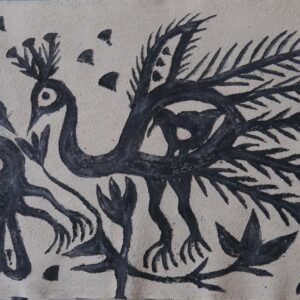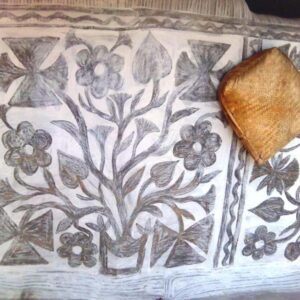Hazaribagh is the headquarter of the North Chhotanagpur Division located on a plateau with the leafy township of middle size surrounded by a number of picturesque forest villages hamlet in hills and valley. The Hazaribagh and adjoining Chatra district have revealed nearly 18 pre-historic rock art sites dated to the Mesol-Chalcolithic period (10,000 B.C) in the Sati, Maudhi and Satpahar hills in the North Karanpura valley, drained by the river Damodar flowing west to east. These painted rock-art shelters referred to by local tribals as Khovar meaning Caves of the bridal couple were first brought to light by Bulu Imam (Convenor INTACH Hazaribagh in 1991.
Khovar (Kho is caveand Vara bridal couple) is a marriage mural art of the tribaland Scheduled castes communities of Hazaribagh (Jharkhand) found throughout the plateau, living in forested hill villages, and agricultural valleys. Khovar or the Comb-Cut art done during the marriage season, a type of sgraffito art using Reversed Slip pottery technique. This technique consists of applying a ground base-coat of manganese black earth Ochre and letting it dry, after which a wet slip of kaolin creamy white earth colour is applied and cut or scraped off in various designs or motifs with a plastic or bamboo comb, or with the four fingers of the hand. The under layer is of a stark contrast with the upper layer, usually black and white. Here are some pictures;
Photo Archives
Khovar painting, Hazaribagh, Jharkhand
Khovar painting, Hazaribagh, Jharkhand
Documentation: Alka and Justin Imam, Hazaribagh, Jharkhand, 2015
Gallery images: 11
Courtesy: Alka and Justin Imam
Copyright: Virasat Trust
Audio-Visual archives I Audio archives I Video archives I Photo Archives
Disclaimer:
The opinions expressed within this article or in any link are the personal opinions of the author. The facts and opinions appearing in the article do not reflect the views of Folkartopedia and Folkartopedia does not assume any responsibility or liability for the same.
Folkartopedia welcomes your support, suggestions and feedback.
If you find any factual mistake, please report to us with a genuine correction. Thank you.












